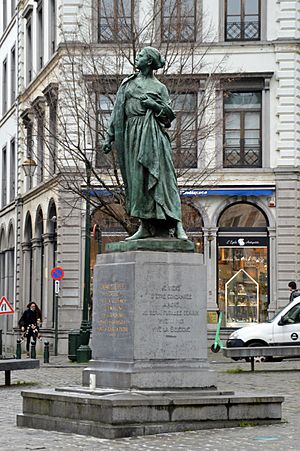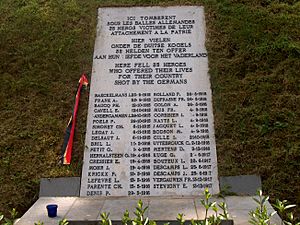Gabrielle Petit facts for kids
Quick facts for kids
Gabrielle Petit
|
|
|---|---|

The statue of Gabrielle Petit in Place Saint-Jean, Brussels
|
|
| Born | 20 February 1893 Tournai, Hainaut, Belgium |
| Died | 1 April 1916 (aged 23) Tir national, Schaerbeek, Brussels, Belgium |
| Buried |
Schaerbeek Cemetery
|
| Battles/wars | World War I |
Gabrielle Alina Eugenia Maria Petit (born February 20, 1893 – died April 1, 1916) was a brave Belgian woman. She worked as a spy for the British during World War I. This was when Germany had taken over parts of Belgium. She was executed in 1916. After the war, she became known as a national hero in Belgium.
Contents
Gabrielle Petit's Early Life
Gabrielle Petit was born on February 20, 1893, in Tournai, Belgium. Her parents were working-class people. After her mother passed away early, Gabrielle grew up in a Catholic boarding school. This school was in a town called Brugelette.
When World War I began, Gabrielle was living in Brussels. She worked there as a saleswoman. She immediately volunteered to help the Belgian Red Cross.
Becoming a Spy for Her Country
Gabrielle's work as a spy started in 1914. She helped her fiancé, Maurice Gobert, who was a wounded soldier. She helped him cross the border into the neutral Netherlands. This way, he could rejoin his army group.
During this trip, Gabrielle gathered important information. She passed it on to British Intelligence. The British soon hired her to spy on the enemy. They gave her some quick training.
She then started collecting information about enemy troop movements. She used different fake identities to do this. Gabrielle also helped distribute a secret newspaper called La Libre Belgique. She also helped an underground mail service. This service was called "Mot du Soldat." She also helped other young men cross into the Netherlands.
Her Capture and Sacrifice
Sadly, a German agent tricked Gabrielle. This agent pretended to be Dutch. The agent worked for the German counterintelligence service. This service was designed to stop spies.
Gabrielle was arrested by the German military police in February 1916. She was held in the Prison de Sint-Gillis in Brussels. She was put on trial and found guilty of spying during wartime. This was under German military law.
She was sentenced to death on March 1. During her trial, Gabrielle was offered a chance to be set free. But she refused to tell who her fellow agents were. She chose to protect them.
On April 1, 1916, Gabrielle Petit was shot by a firing squad. This happened at the Tir national execution field in Schaerbeek. Her body was buried there.
Remembering a Hero
Gabrielle Petit's story was not widely known until after the war. Then, people began to see her as a hero who died for her nation. In May 1919, a special state funeral was held for her.
Many important people attended. These included Queen Elisabeth of Belgium and Prime Minister Léon Delacroix. Her remains were buried with full military honors. This happened at Schaerbeek Cemetery.

A statue of Gabrielle Petit was put up in Brussels. This was special because it was said to be the first statue of a working-class woman. In her hometown of Tournai, a square was named after her. After the war, several books and films were made about her life.

